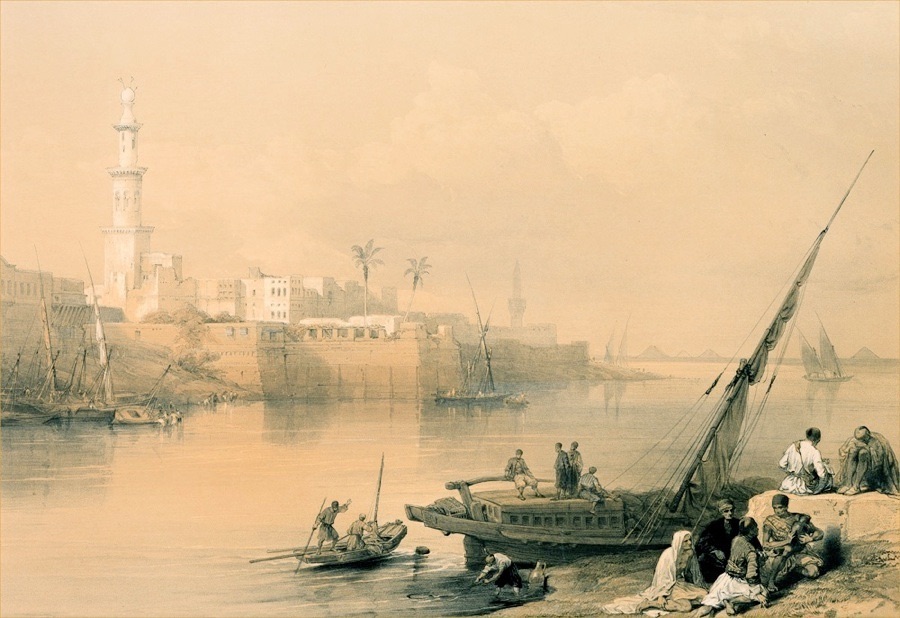VIEW ON THE NILE. ISLE OF RHODA, AND THE FERRY OF GHEEZEH
THE island of Rhoda lies off the shore about a mile from Cairo, and is reached from the city through olive-grounds which were planted by Mehemet Ali. The gardens of the island were rendered beautiful by Ibrahim Pasha, and are now so luxuriant in vegetation that its appearance to voyagers who descend the river from the south is hailed almost with the pleasure that an oasis is welcomed by the traveller in the Desert. A visit to Rhoda is one of the pleasure excursions of the Caireens, who visit these gardens to enjoy a spot so fresh and beautiful.
The island is nearly opposite to Old Cairo or Fostat, and near to the principal ferry of the Nile at Gheezeh. It owes its name to the abundance and beauty of the roses which are profusely cultivated there, everywhere clustering, and as they overhang the walls, they offer one of the greatest charms of the agreeable island, filling the eye with their beauty, and the air with their fragrance.
These gardens belonged to Ibrahim Pasha, and were laid out under the direction of Mr. Trail, a Scotchman, who was sent to Egypt for this object by the Horticultural Society of London. Walks through borders and masses of myrtle lead among groves of orange and pomegranate trees in full bearing, and trellises of vines. Fountains surrounded and gratefully shaded by cypresses; and the trees and fruits of the East, bananas and date-palms, mingle with the mulberry and the laburnum of the West, and all offer fragrance and freshness at every turn, whilst canals for irrigation everywhere wind and distribute their fertilising effects. Sometimes, however, extraordinary rises of the Nile have carried destruction for a time to these beautiful gardens.
There is an interesting tradition that it was on this island, always chosen by the princes of Egypt for its beauty and retirement, that the mother of Moses placed him, among the bulrushes on the banks, and where he was found by Thermuthis, the daughter of Pharaoh. The localities of these biblical traditions give intense interest to the visits made in these lands; but there are travellers who, in the mere spirit of contradiction, boast of a scepticism which is weaker than belief.
In our view the spectator looks up the river; the pyramids in the distance are those of Saccara. The busy and bustling scene near the great ferry is full of animation; picturesque boats lie near, and everywhere groups of Turks, Arabs, and Nubians, present subjects for the pencil of the artist. The tower of the Nilometer or Mekyas, within which is enclosed, in a deep walled square well or basin, the pillar by which the rise of the Nile is measured, is situated at the southern extremity of the island, on the spot marked by tradition as that where Moses was found in the bulrushes. The water stagnates within it, except at the season of high tide, and the whole building bears the appearance of dilapidation and decay, like all other buildings in Egypt, except those of modern erection raised for pleasure and retreat, such as the Kiosks, which are perched in fine situations. One of these on the island of Rhoda is three stories high, and presents from its summit a beautiful panorama. "I stood upon the little balcony of one of the windows," writes a lady, "quite enchanted with the scene; immediately below me lay the whole extent of the island, spread out with all its parterres and terraces, like a map of many colours girded by the silvery river, whose coarse stretched on either side as far as the eye could reach. Cairo was behind me, but immediately in front stood out the colossal Pyramids in bold relief: a blue misty haze intervened, and reminded me of the many miles which separated us. I could have looked and looked for ever, but some carpenters who had been working at the windows were pestering me for backshesh, and would not allow me to enjoy it long."
Wilkinson's Egypt.
St. John's Egypt and Nubia


